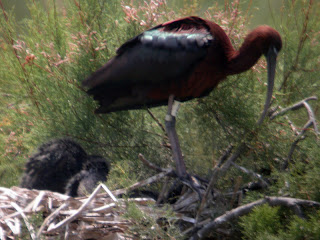MATALASCANAS CLIFFS – COREDOR DE VERDE – DEHESA ABAJO – NORTHERN MARSHES – JOSE VALVERDE CENTRE.
We were taking a few days break by the seaside and the hotel we used just happened to be in the heart of Coto Donana ( I wonder who picked the hotel?). It was also a coincidence that a Canadian Birder required a day tour during our stay there.

JEAN HARDY
It was a bright clear morning, a slight breeze and quite warm. I collected Jean from his hotel at 8am, it happened to be the Parador de Mazagon which is just along the coast from matalascanas where we were staying. We drove to the cliffs at Matalascanas to sea watch for a while, jean needed to see a couple of gulls and shearwaters. Only the Yellow-legged Gull turned up it was very quiet out there, a good number of Northern Gannets (all sub-adults) was diving into the sea for their breakfast.
We drove north passed El Rocio noting Flamingos, Spoonbills and Black-winged Stilts on the Marismas and along the road we saw Common Buzzard, Black Kite, Azure-winged Magpies, Woodchat Shrike, Corn Buntings and lots of White Storks on their nests, the youngsters are now ready to fledge and spend a lot of time exercising their wings.

GLOSSY IBIS AT NEST
We turned east and drove through Villamonrique before turning onto a track that led us to the Rio Guadimar which forms the Corredor de Verde. At a concrete bridge we stopped to look at Red-rumped Swallows, both beautiful and graceful in their delicate flight manoeuvres. Also noted at the bridge were Serin, Hoopoe, Bee-eater, Crested Lark and Common Nightingale.

PURPLE HERON CHICKS
We walked along a path that led us into some open woodland where we found one target bird the Golden Oriole, a male seen in flight. A pair of Booted Eagles circled above us as we watched Greenfinches, Goldfinches, Spanish Sparrows and more Serins, all unusual sightings for the Canadian eye to behold.
At Laguna Qema we added Common Coot, Common Pochard, Great crested Grebe, Little Grebe and Moorhen to the tally. We also stopped at the laguna Zorita where Tree Sparrow, Thekla Lark, Common Swift, Yellow Wagtail and Spotless Starling were seen and a Quail was heard calling from the fields behind us.

NIGHT HERON WITH SNAKE
At Dehesa Abajo there was a good numbers of birds in the distance, mainly Spoonbills, Greater Flamingos, Mallard, Common and Red-crested Pochard and lots of Great Crested Grebes. We did see Great Reed Warbler, Cetti’s Warbler Olivaceous Warbler (briefly), Jackdaw, Common Kestrel, Zitting Cisticola, Reed Warbler and Whiskered Tern. A heavy cloud base had formed behind us and we were in for a thunderstorm, large spots of rain began to fall.
We quickly drove to the ‘gravel pits’ which are found along the road towards Pueblo del Rio. On one of the pools we found 5 adult Red-knobbed Coots (4 of which had white collars to indicate that they were released birds), there were also a number of chicks being fed by the adults, how nice to is to see a rare bird breeding like this. Also on the small pool we found lots of Little Grebes feeding young, Mallard and a couple of Night Herons.
The last area to be visited was the Northern Marshes and the Jose Valverde Centre which meant that we had to drive through the thunderstorms and rain.
It wasn’t as bad as it looked, we stopped the car during the heaviest of the rainfall whch didn’t amount to much. Along the tracks towards the Valverde Centre we noted Lesser Kestrel, Lots of Cattle Egrets, Little Egret, Marsh Harrier, Black Kites and many Short-toed Larks on the track. We stopped to look at Calandra Larks and search for Lesser Short-toed larks and in doing we also found Purple Heron (flying over) and Skylarks on the ground. As we passed alongside the marshes we saw many, many Great Crested Grebes and Common Coots with chicks, a sign that the wet winter was paying off for some species.
Near the Valverde Centre we tried to track down a calling Purple Swamphen but if failed to show be we did see hundreds and hundreds of birds in the sky of many different species. The breeding colonies of Glossy Ibis, Purple Heron, cattle Egret, Little Egret, Night Heron and Squacco heron were all very busy with lots of chicks in the nests. Common Pratincoles filled the air with Whiskered Terns, and Black Kites. The marshes were littered with good numbers of Greater Flamingos. Spoonbills, Egrets, Ibis, Black-winged Stilts and Common Coots.
From the plate glass viewing windows at Velverde we notched our only Little Bitterns and had good close views of most of the breeding colony.
Soon it was time to make the return journey, along drive back to Mazagon, we made several short stops along the way where we added Black-tailed Godwit, Montagu’s Harrier, Griffon Vulture (and a very high Black Vulture that disappeared into the cloud), we also counted 10 lesser Kestrels in one field.
Our day finished at the Parador at 6:30pm and as Jean waved goodbye in the driveway a couple Azure-winged Magpies flew over, good day – good birding!




















